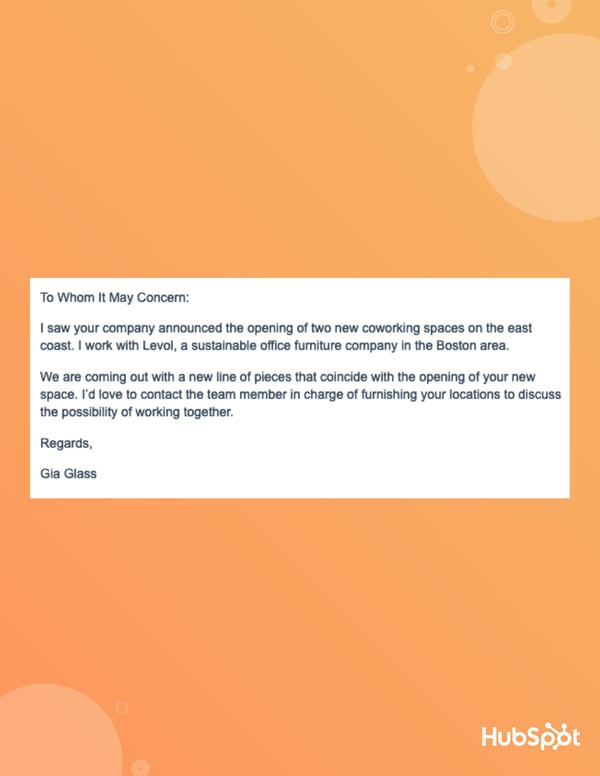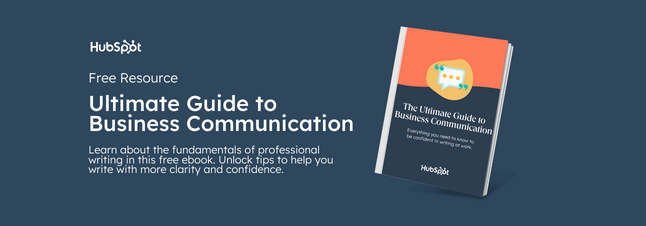So, before you slap another "To Whom It May Concern" on your outreach email or cover letter, read through this simple guide to determine when to use it, how to use it, and which alternatives to consider instead.
To Whom It May Concern
"To Whom It May Concern" is a broad way to address professional or formal correspondence. It’s widely used when the recipient’s name or title is unknown, such as when you are providing a recommendation for a former colleague and do not know the name of the hiring manager.
When to Use "To Whom It May Concern"
Before each piece of correspondence you send, ask yourself, "Who is the intended recipient of this message?"
If the answer is, "Anyone," you should be safe to use, "To Whom It May Concern." If, however, your end reader is someone with a specific role or title, keep digging to find their name. It can be difficult to know when it’s appropriate to use "To Whom It May Concern," so here are a few scenarios where it’s usually alright:
1. Reaching out to a large company or new department
If you are reaching out to a large company with a complex organizational structure and aren’t sure who the proper point of contact is, you may need to submit a message through a message form on the company’s website or sending an email to a general address such as "contact@xyzcompany.com." In this case, "To Whom It May Concern" may be appropriate. When taking this approach, we recommend asking for the right point of contact for your request in the body of your message.
Example:
To Whom It May Concern:
I saw your company announced the opening of two new coworking spaces on the east coast. I work with Levol, a sustainable office furniture company in the Boston area.
We are coming out with a new line of pieces that coincide with the opening of your new space. I’d love to contact the team member in charge of furnishing your locations to discuss the possibility of working together.
Regards,
Gia


2. Recommendations/reference checks
If you’re providing a reference or recommendation for a former colleague or employee, the request might come through an automated system that doesn’t include any information about the hiring manager.
They don’t expect you to research them or their company, they just want your thoughts on the candidate they’re about to hire. This would be an acceptable time to address your audience with, "To Whom It May Concern."
Example:
To Whom It May Concern:
Dwight was an excellent employee during his three years at Dunder Mifflin.
He took his work very seriously, volunteered for projects outside his regular duties (i.e., volunteer floor fire warden and safety officer), and was our top-performing salesperson all three years. I would highly recommend him for this position.
Regards,
Michael Scott

3. Company complaints
Lodging a formal complaint with a company? It likely doesn’t matter if that complaint reaches an administrator, customer service associate, or the CEO — you simply want your complaint to be heard and addressed.
Example:
To Whom It May Concern:
I was extremely disappointed the cat poster I ordered only has three jazz-playing cats instead of the four depicted on your website. I would like a full refund and the correct poster as soon as possible.
Thank you,
Angela Martin

4. Introductions
If you are introducing yourself to someone you’ve never met, it could be appropriate to use, "To Whom It May Concern." For example, if you received a request for a quote, or information regarding your business, from a generic company inbox or feedback form, you might address your response, "To Whom It May Concern." Just make sure to ask for their name in your message.
Example:
To Whom It May Concern:
I received your request for a price quote on 50 reams of paper from Dunder Mifflin. I’ve attached the quote to this email and would be happy to answer any questions you have.
Also, I’d love to know your name and a little more about your business!
Kind Regards,
Phyllis Vance

5. Prospecting
This is acceptable but not ideal. If you’re a salesperson conducting outreach — it’s your job to put in the time and research to know exactly who you’re contacting.
Ideally, you should build rapport with them over LinkedIn or Twitter — or reaching out via a mutual connection — first. If there seems to be no way to find their personal information, you might reach for "To Whom It May Concern," but don’t expect a high response rate.
Example:
To Whom It May Concern:
I noticed your company recently parted ways with its paper supplier. I work with Dunder Mifflin, a local Scranton paper supplier, and would like to speak with the person in charge of paper ordering at your company.
We pride ourselves on personalized customer service and fast delivery, and I’d love to see if we’re the right fit for you.
Best,
Jim Halpert

How To Write "To Whom It May Concern"
If you’re using a formal greeting like "To Whom It May Concern," it’s important to format it correctly. Here's how to write "To Whom It May Concern:"
- Capitalize the first letter of each word
- Always use "Whom" instead of "Who" or "Whomever" (In the case of "To Whom It May Concern," "Whom" is the object of a verb or preposition and is appropriate to use in this context)
- Use a colon after "To Whom It May Concern" rather than a comma
- Add a double space before beginning the body of your message
As we’ve identified above, if you’re using "To Whom It May Concern" you’re likely approaching a business formal conversation. Don’t let sloppy formatting muddle your first impression. These tips should always set you up for success.
When Not To Use "To Whom It May Concern"
Whenever possible, avoid "To Whom It May Concern." It’s largely outdated, stuffy, and lazy. With our access to the internet today, it’s fairly simple to find the name and even email address of the person with whom we wish to speak.
Because of this, "To Whom It May Concern" can demonstrate a lack of effort in correspondence which doesn’t set a positive tone for the rest of your business relationship.
Here are a few tips for finding almost anyone’s name:
- Ask your HR rep or recruiter - If you’re writing a cover letter or email to a hiring manager, ask your recruiter or HR rep for the correct name.
- Visit the company’s LinkedIn profile - At the top of their profile, you’ll see a hyperlinked prompt that says, "See all [number of employees] on Linkedin." Click that prompt to see a list of all employees. You should be able to skim the list until you find the person, role, or title you’re hoping to connect with.
.png?width=600&name=To%20Whom%20It%20May%20Concern%20The%20Quick%20and%20Simple%20Guide%20to%20Using%20This%20Phrase%20(With%20Examples).png)
- Visit the company’s "About Us" page - Smaller companies might list all employees and their titles on their "About Us" or "Team" page. At the very least, you’ll find a general company inbox where you can send a request to learn the name of the person you’re trying to reach.
- Pick up the phone - Call the company where your prospect works and ask the receptionist or administrator for that person’s name, contact information, or advice on how best to reach them.
It might take a few extra minutes, but finding the name of the person you’re reaching out to is important. Show your email recipient their name matters to you and find it before resorting to "To Whom It May Concern."
If you happen to find your contact’s name from doing your own research, you’ll want to be honest with them about how you found their information.
Example:
Hi Kayla,
We have some mutual connections on LinkedIn, and I saw your recent post requesting introductions to sales automation specialists.
This is an area of expertise for my organization. Would you like to schedule an introductory phone call? I would be happy to answer any questions you have.
Regards,
Tyler Thompson


Sometimes it’s just not possible to find a contact’s name. In these cases, here are a few alternatives.
1. "Dear Hiring Manager"
When applying to a new position, it's not always possible to know the name of the hiring manager. If you can, figure it out with some good-old-fashioned LinkedIn sleuthing. If not, this greeting is an appropriate choice.
2. "Dear Recruiter"
Similarly, if you're unable to identify the recruiter or gatekeeper for the role you're applying for, "Dear Recruiter" is a widely used greeting.
3. "Greetings"
Save this for colleagues or business associates you already have open and casual correspondence with. It's friendly and familiar, so leave it behind for more formal introductions.
4. "Dear Recruiting Department"
If you're applying for a job with a larger company, your application may be directed to a broad recruiting inbox. In this case, you're not writing to a specific person and might need the approval of several recruiters. This greeting ensures you're casting a broad net.
5. "Dear [Name of department you’re interested in]"
If you're selling to a specific company department and are unsure who your target buyer is, addressing your email to the department alias is best. It's not ideal but if you can't identify the right contact person, don't be afraid to send this greeting.
6. "Dear [Name of the title or role of the person you’re pursuing]"
Know the title of the person you're writing to? Great! Hopefully you can use that information to find their actual name — if not, addressing them by their title (i.e., "Dear Marketing Director") is an acceptable, if not slightly distant, way to reach out.
7. "Dear Customer Service Manager"
Whether you're addressing a message to a business contact or reaching out to customer support for a personal matter, it's smart to put your best foot forward. A more formal, respectful greeting is sure to be appreciated.
8. "Hello"
Already mid-conversation with the person on the other end of your email? Open with a casual "Hello" and continue your message thread.
9. "Dear Search Committee"
Perhaps you find yourself addressing an email to a final panel of buyers, or maybe you've made it to the final round of interviews for a new job. Regardless, if you need to send an email to a group of people in one of these scenarios, this greeting works well.
10. "Dear [Name]"
An oldie but a goodie. This greeting is almost always appropriate. When in doubt, pull this one out.
11. "Hi Friend"
Reserve this familiar greeting for non-professional email correspondence — think happy hour plans and weekend BBQs.
12. "Season's Greetings"
Looking for a way to give your emails some inclusive, work-appropriate holiday cheer? Dust off "Season's Greetings" — just don't forget that apostrophe 's.'
13. "Hello There [Name]"
This is another less formal way to open your correspondence. Save it for peers, colleagues, and business associates with whom you already enjoy open rapport.
14. "Good Morning"
Sending an email you know will be read right away? Alluding to the time of day with a "Good Morning" or "Good Evening" is suitable for all audiences.
15. "Good Day"
Feeling international? "Good Day" isn't a common greeting in the United States, but it might just enliven your next Monday morning email.
The internet removes many excuses for using "To Whom It May Concern." Before you slap it in an email, consider the recommendations in this post. And wipe a few other outdated or lazy phrases from your vocabulary, including "Looking Forward to Hearing From You," "Best Regards vs. Kind Regards," and "Dear Sir or Madam."
Sales Communication


.png)


![Active Listening Techniques To Use On Your Next Sales Call [+ Examples]](https://53.fs1.hubspotusercontent-na1.net/hubfs/53/active-listening-1-20250218-4164086.webp)
![How to Reply to a Sales Rejection Email From a Client [+ Templates]](https://53.fs1.hubspotusercontent-na1.net/hubfs/53/timing-objection-responses-1.jpg)




%20(1).png)

